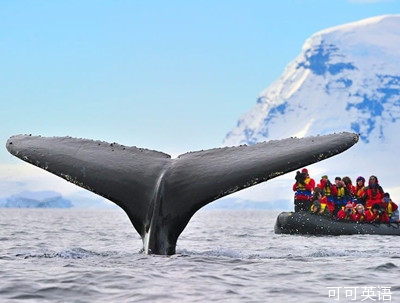Chimps show other chimps how to use tools. My roommate showed me some tricks to make better scrambled eggs.
猩猩向其它猩猩展示如何使用工具。我的室友向我展示如何做更好的炒鸡蛋。
Group members teaching each other is called cultural transmission.

And a study finds that cultural transmission is behind the spread of a hunting technique among humpback whales off New England.
一项研究发现文化传播落后于新英格兰海岸线座头鲸之间捕食技巧的传播。
The research is in the journal Science.
这项研究发表在《科学》杂志上。
It's called "lobtail" feeding: a humpback whale slaps the surface of the water with its tail.
这就是所谓的“挑尾”捕食:一条座头鲸用尾页拍打海水表面。
The resulting bubbles pen in prey fish, which the whales gobble up.
由此产生的泡沫将猎物围起来,于是座头鲸便狼吞虎咽吃掉猎物。
Researchers first saw lobtail feeding in 1980.
研究人员于1980年首次观察到这种“挑尾”捕食。
Within 30 years, 37 percent of observed humpbacks had picked up the technique.
30多年间,所观察的座头鲸中有37%学会了这种技巧。
To create mathematical models for the spread of lobtail feeding, researchers used 27 years of data from whale-watching boats in the Gulf of Maine.
为了创建“挑尾”捕食传播的数学模型,研究人员利用了27年来在缅因湾赏鲸船上收集的数据。
And the models that included cultural transmission as a factor best matched the data.
将文化传播作为参考因素的数学模型与数据的匹配结果最理想。
Those models assumed that humpback whales that spend more time with lobtail feeders were more likely to pick up the method themselves.
模型显示花更长时间进行“挑尾”捕食的座头鲸更有可能是自学的。
Clearly, whales are capable of sophisticated social interactions—and we've only seen the tip of the tail.
很明显,鲸类有能力进行复杂的社会互动,但我们只观察到拍打的尾巴。



